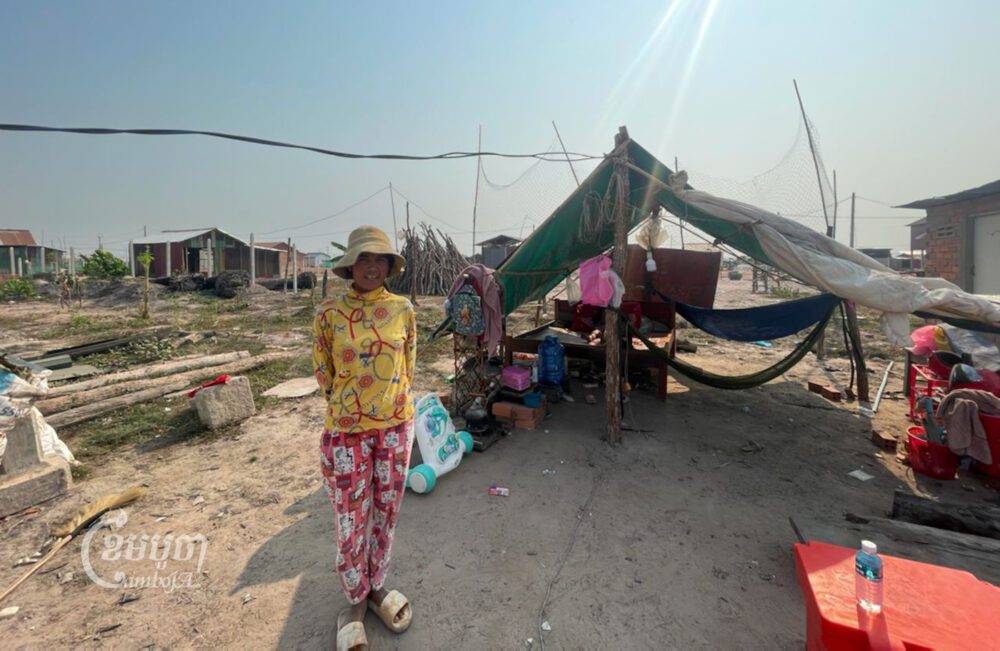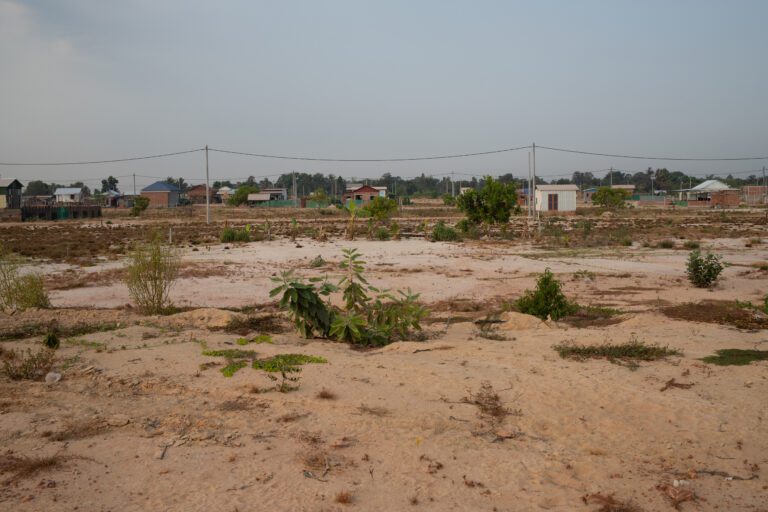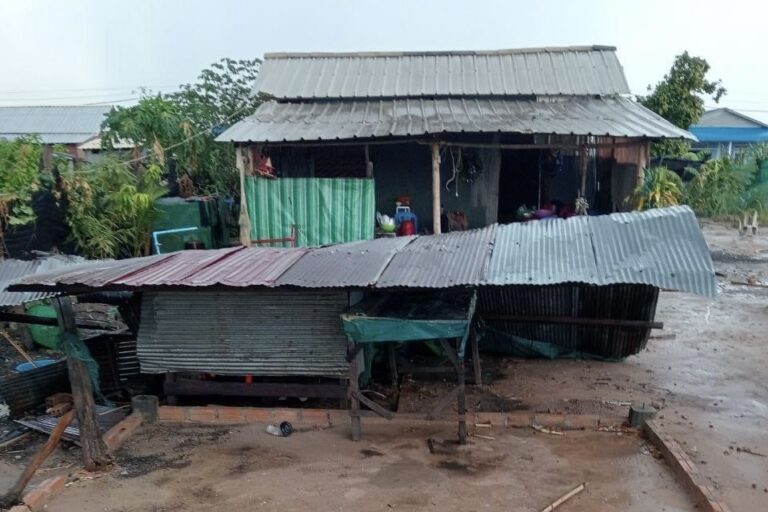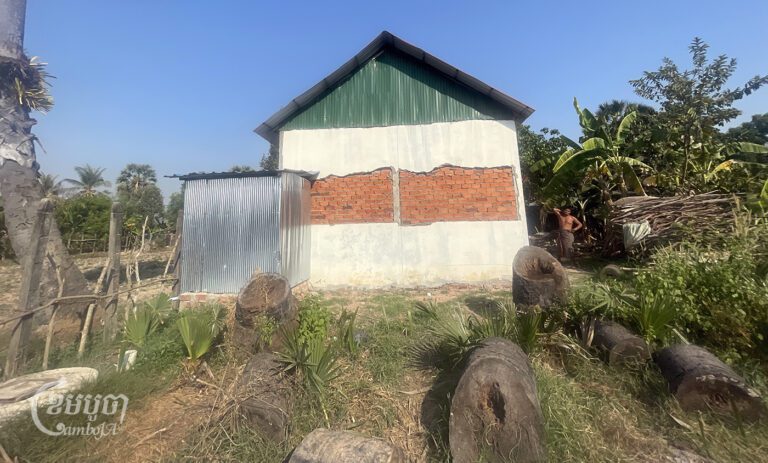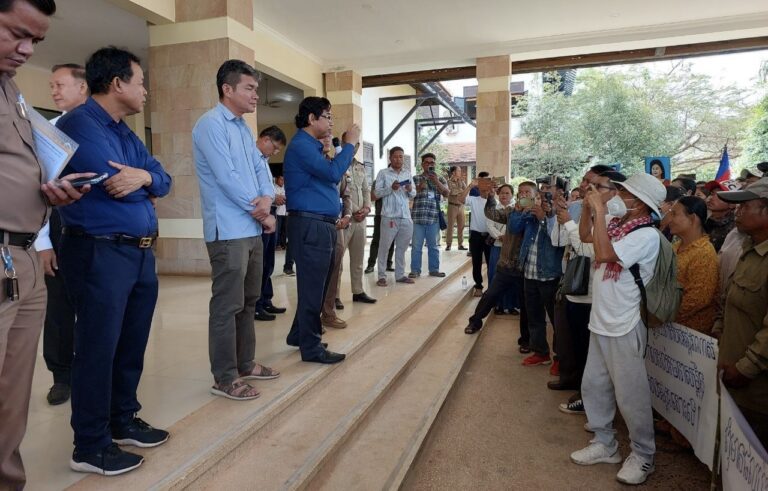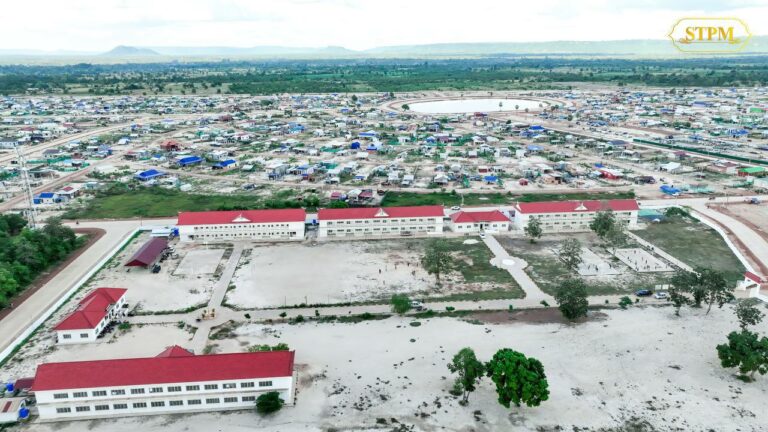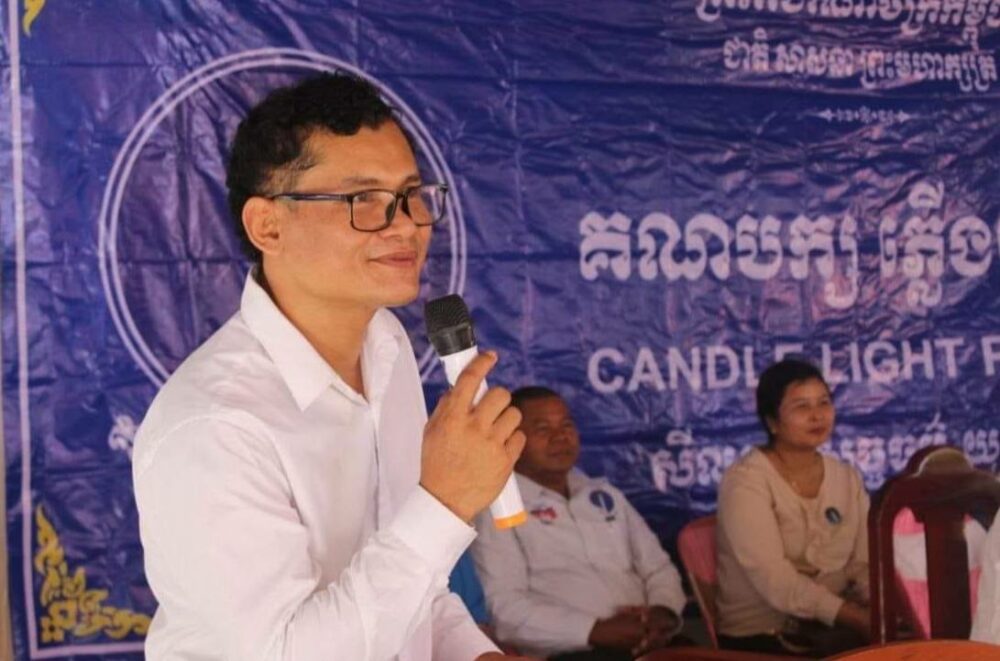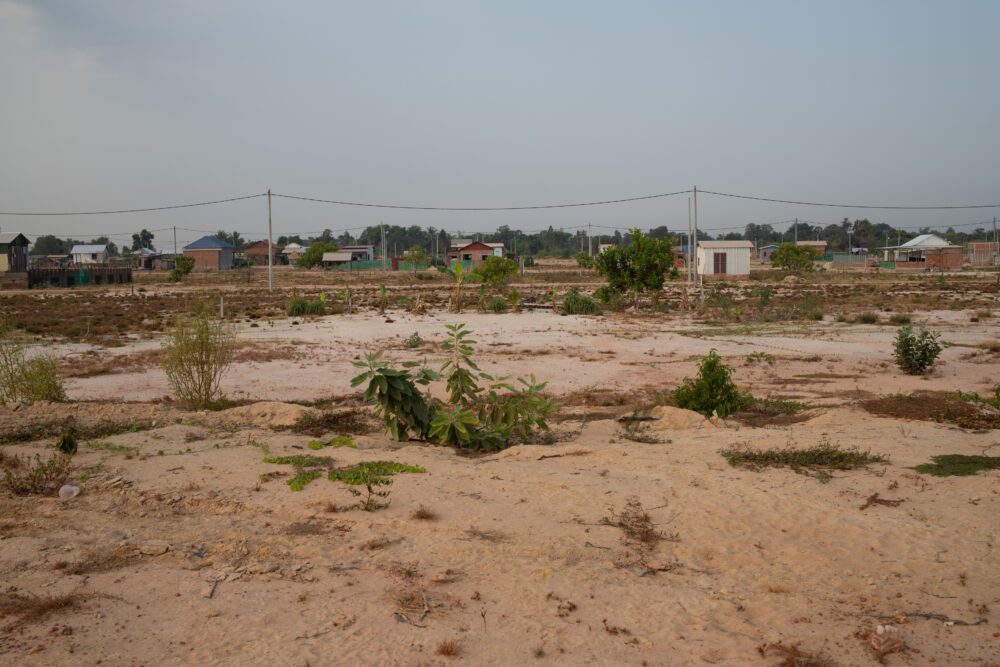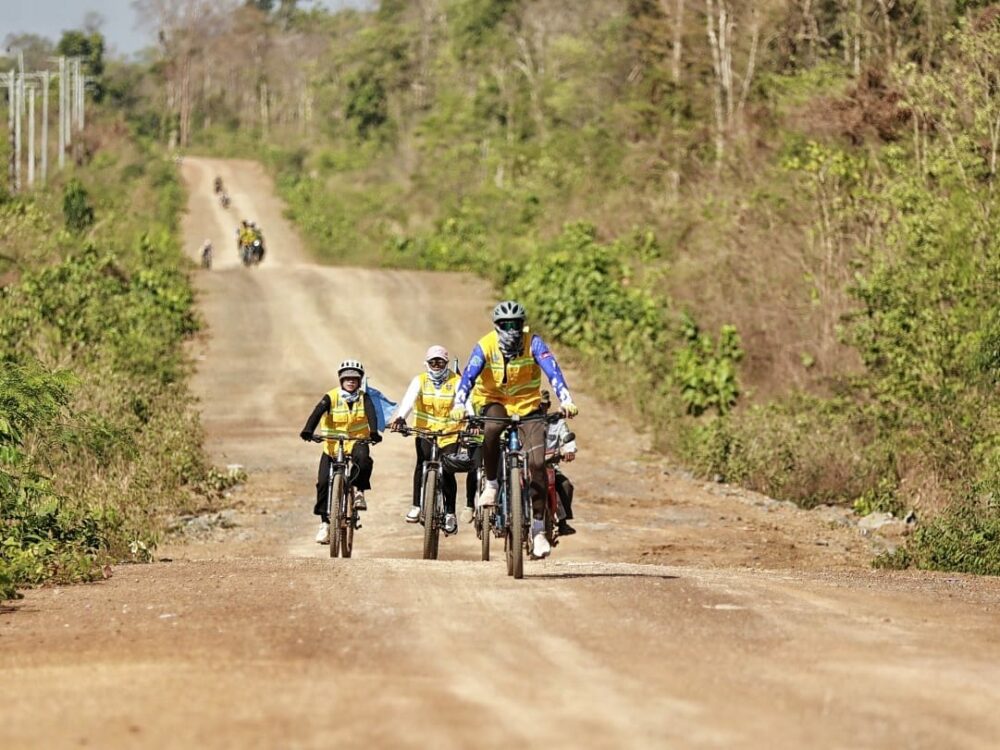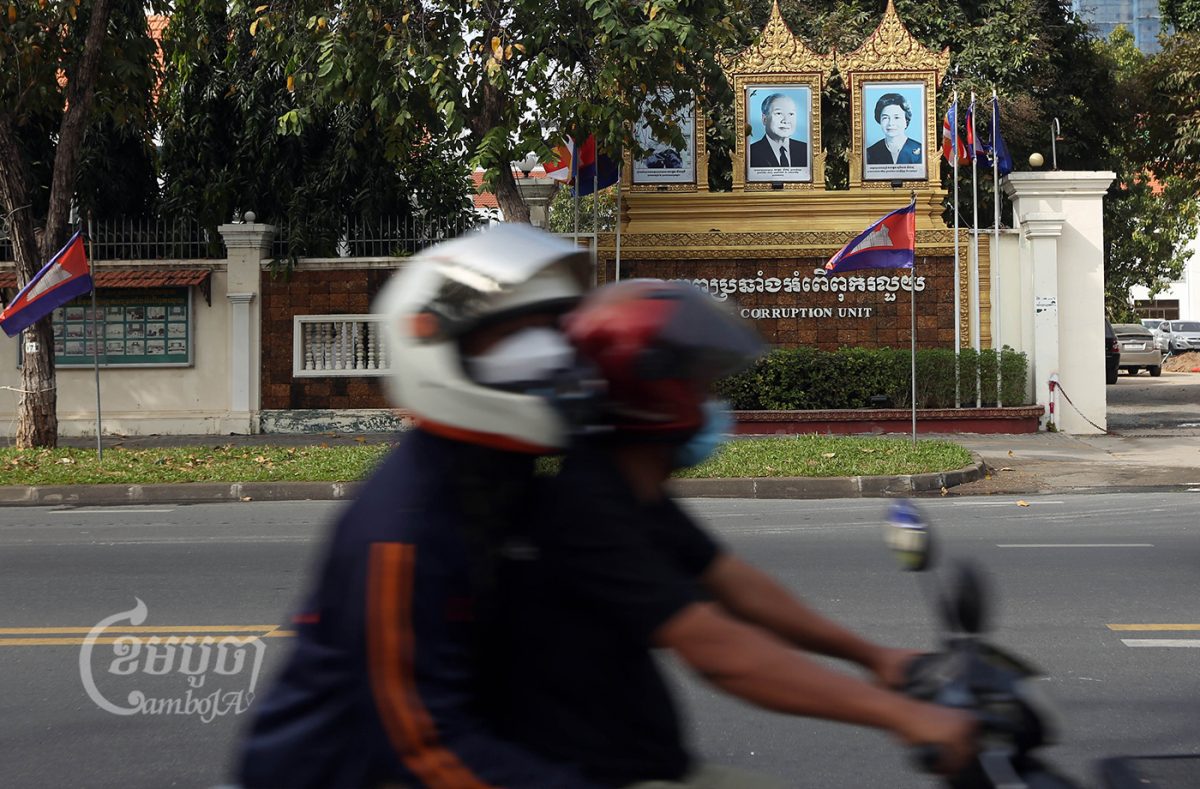Standing beside her newly constructed wood and tin hut in February, Thida wistfully recalls her old home inside the Angkor Archaeological Park, where she lived for more than 20 years.
“I want to live in my old place, I really miss my hometown,” said Thida, whose name has been changed to protect her identity because she is a government employee.
The middle-aged Thida and her family of six are among approximately 2,000 families who since November 2022 have been relocated from their homes near the historic Angkor temples to a new site more than 30 kilometers away in Banteay Srei district’s Run Ta Ek commune. Thousands more families inside the park face relocation, as part of an ongoing effort to clear settlements that the government says damage the environment and could harm the temple’s World Heritage Status.
The Cambodian government has repeatedly claimed these resettlements are voluntary, including in an official report on the state of Angkor conservation received by the United Nations Educational, Scientific and Cultural Organization (UNESCO) World Heritage Center in December 2022. The report to UNESCO also portrays the relocation site as having been “equipped” and prepared to receive families in “decent and safe conditions.”
But a CamboJA investigation reveals that many families felt they had no choice but to move to the Run Ta Ek relocation site, echoing prior media reports.
Far from arriving at an “equipped” site, many families sent to Run Ta Ek have had to build and partially fund their own home construction after arrival and now struggle to maintain their livelihoods. The government also shared an aerial image of Run Ta Ek to UNESCO in its report of a previously developed village not representative of the conditions in the area where most newly relocated families have been sent to live.
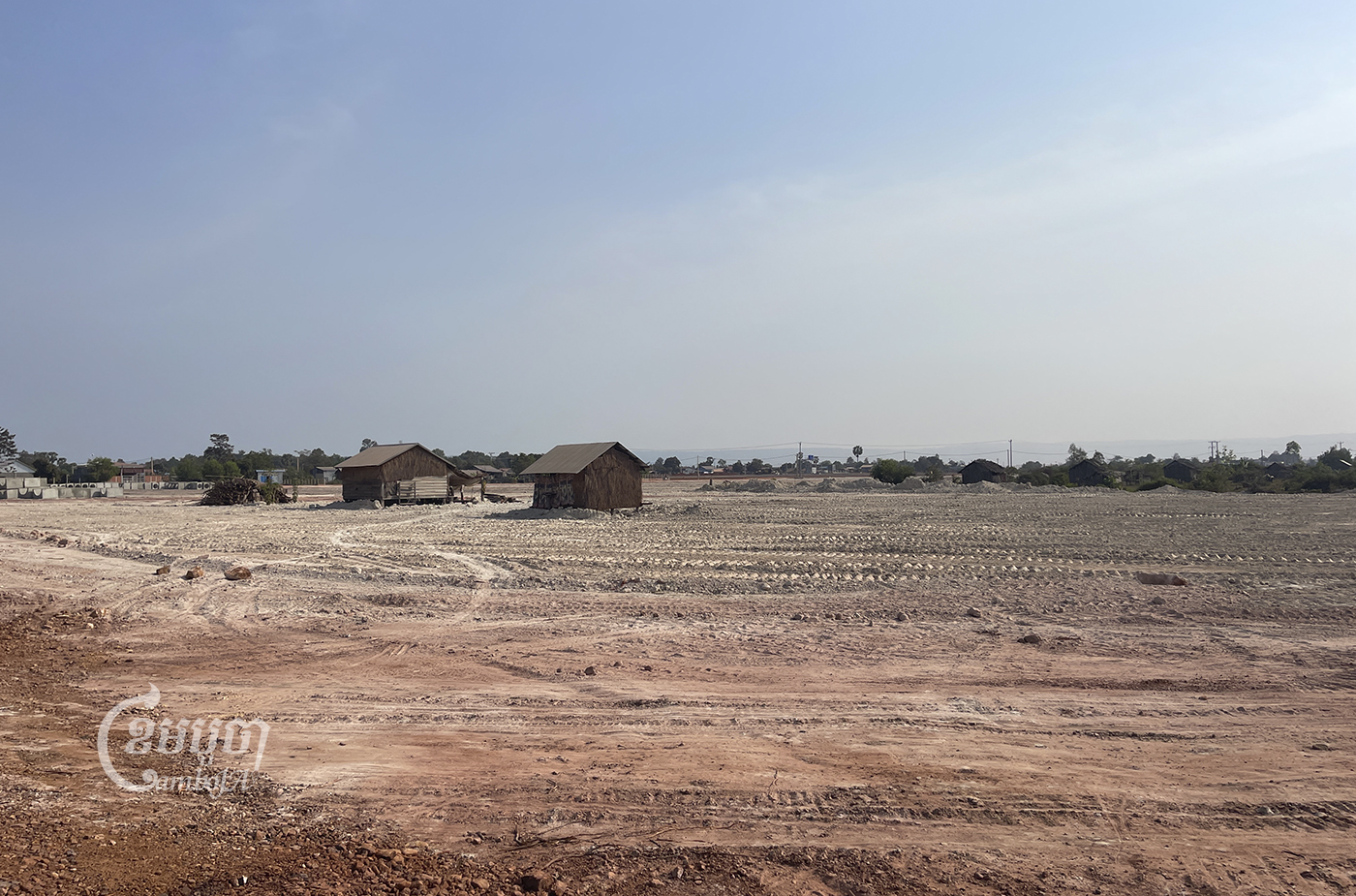
Amnesty International released a statement Friday noting many people who had lived around Angkor were coerced into moving to Run Ta Ek, which lacked necessary infrastructure, clean water, shelter upon their arrival. Relocated families were not given “genuine consultation” and access to legal protections regarding their evictions, Amnesty found.
“These are forced evictions in disguise and on a mass scale,” said Ming Yu Hah, Amnesty International’s Deputy Regional Director for Campaigns, in a statement. “People were pressured to volunteer and made to feel fearful of reprisals if they refused to leave or challenged the evictions.” Forced evictions, as Amnesty International alleges, are considered human rights violations under international human rights law.
Many of those forcibly evicted had lived in their homes for decades, and built up gardens, well-trodden roads, farmlands and were even connected to the electrical grid. Cambodians have always lived in and around the Angkor temples since they formed the pinnacle of the Khmer empire in the 12th century. Angkor was removed from UNESCO’s “Danger List” in 2004, after Cambodian authorities secured the park against pillaging, excavations and land mines. But a surge in families occupying land inside the complex since the 1990s has led UNESCO and Cambodian authorities to express repeated concern for the conservation of the temples.
Cambodia’s Land Minister Chea Sophara, who said his ministry identified more than 8,400 illegal structures inside the Angkor Archaeological Park between 2019 and 2022, called them “shaming buildings” in a speech last year.
Siem Reap is one of Cambodia’s poorest provinces and economic opportunity is clustered around the tourism industry at Angkor, which services upwards of 2 million foreign visitors annually and is a linchpin of the Cambodian economy. Families can earn a living selling souvenirs, guiding, or working at restaurants and hotels around the Angkor park. In part, authorities fear an expanding population’s groundwater use threatens the stability of the Angkor temples. But this is also largely due to unregulated use by surrounding hotels, restaurants and other aspects of the tourism industry in Siem Reap.
Prime Minister Hun Sen said in September that the mass relocation is intended to appease UNESCO, and to allow the Angkor park to remain classified as a World Heritage site.
UNESCO has denied involvement with the relocations, though it exerts heavy influence over management of the Angkor complex and has repeatedly urged for the removal of illegal structures inside the park.
UNESCO’s country representative endorsed the destruction of hundreds of homes built illegally inside the Angkor Archaeological Park, according to 2017 media reports. In December, a group of UNESCO-affiliated conservation experts recommended APSARA continue “dismantling” illegal buildings.
“UNESCO is not a party to this relocation program and has not made any request for population relocation to the Cambodian authorities,” UNESCO said in an emailed statement to CamboJA. “UNESCO underlines, for all the sites in the world, that the conservation measures decided by the authorities must involve, take into account the opinion and respect the rights of local communities.”
Long Kosal, spokesperson for Cambodia’s APSARA National Authority managing the Angkor park, denied allegations of forced evictions and told CamboJA that approximately 10,000 families had volunteered to go to the new sites, including Run Ta Ek.
The Minister of Culture and Fine Arts Phoeurng Sackona, whose ministry oversees APSARA and co-authored the report to UNESCO, said in an emailed statement to CamboJA that “APSARA has nothing to hide.”
Yet many villagers being sent to the new Run Ta Ek site repeatedly told CamboJA that they did not volunteer to relocate. They said they feared if they did not leave then their homes would be forcibly demolished and felt powerless before authorities.
“I had no choice,” said Hoeum Chhat, who was resettled to Run Ta Ek in December and has lived under a tarp for months. “We had to go. We wanted to stay [at Angkor], but we couldn’t.”



Negative Impacts on Livelihood
More than 5,600 families have been sent to Run Ta Ek from the Angkor complex as of February and thousands more are still to come, according to Chuon Im, Run Ta Ek’s commune chief.
“The relocation has been made in stages because in some blocks land has not been cleared yet, so we do not allow them to move in until everything is completed,” Im said.
But relocated families have suffered the economic consequences of their displacement and many were forced to fund construction of their own homes, through their own labor, and contribute to other significant costs of their relocation after arriving at the site’s barren landscape.
Once sent to Run Ta Ek, mother of four Thida said she had to take out a $2,700 loan, in part to buy a new motorbike to travel to work back in the Angkor complex where she has worked as an APSARA temple guard for more than two decades. She earns $225 monthly from her government job.
“I am starting a new life because we are facing many difficulties and I don’t know how many years it will take for my life to be back to normal,” Thida told CamboJA in mid-February. “Now the issue is having no money to build a new house.”
Like other relocated families, Thida’s was enrolled in the government’s ID Poor program and now her family receives $90 monthly in cash support. When families relocated, they also received around $300 in cash, a 20-by-30 meter plot of land, corrugated iron sheets, two months’ food supplies, a mosquito net, and a tarpaulin sheet, Amnesty International reported.
Thida’s neighbors have also struggled to earn a living in the new site, far away from visiting tourists and Siem Reap city.
“Before I could earn at least $5 a day from selling vegetables, but after moving here I have nothing to do and life is hard because I have to spend more [money] buying rice and for my children to study [in the city],” said Lun Nhanh, 46, who was sent to Run Ta Ek with her four children in October.
While there is a primary school nearby, a secondary school remains under construction.
Kosal, the APSARA spokesperson, said infrastructure for Run Ta Ek and Peak Sneng, another relocation site, is being developed.

Authorities’ report to UNESCO includes maps and graphics showing plans for roads, a pagoda, a market, electrical connections, and a drainage system. Run Ta Ek has seen a flurry of construction in the past months, though most of these developments were only initiated in late December after people had already begun arriving at the site, according to Lach Lom, deputy chief of Tani village which includes the new Run Ta Ek relocation site. By mid-December, nearly 600 families had arrived.
APSARA denied claims that relocation had made people’s lives harder.
“You must analyze and look at all aspects of the government’s policies that have been working to support people’s well-being,” APSARA spokesperson Kosal said. “No government has organized the development that makes people poorer.”
But many residents do not agree with this assessment.
Some, like Meas Phearun, had to quit jobs in the city because the two hour round trip commute was exhausting. Phearun, who formerly worked at a hotel spa in Siem Reap city, has opened up a small grocery store at Run Ta Ek but says sales are quiet on the weekdays as most residents travel outside of the area to work.
Nanh said she had lived within the Angkor complex for more than two decades and was dismayed to end up in a dreary stretch of land without trees or crops. She had to take out a $1,000 microfinance loan to support her family during the relocation and said the new living situation was not as good as her old home.
“There is nothing to be happy about for me because there is nothing to do here, I do not know when [it will be better],” she said.

Government Claims Fall Short of Reality in Report to UNESCO
As the evictions throughout the Angkor park progressed, Cambodian authorities submitted a report to UNESCO at the start of December, written exclusively in French and outlining the status of conservation at Angkor from 2021 to 2022.
While stating the government had the right to displace the residents, the report claimed 9,000 families were resettled on “a basis of volunteering” into “decent and safe conditions” and “equipped areas, where agricultural and commercial activity is largely open,” according to an unofficial English translation.
Directly beneath this text, authorities presented an undated aerial image described as an “overview of the Run Ta Ek area.” The image shows a cluster of houses circling a lake and surrounded by forest which does not align with the area where many newly relocated families arrived: a dusty and barren landscape without existing homes.


A review of satellite images, and confirmed by on-the-ground reporting by CamboJA, suggests the site presented in the report to UNESCO depicts an older and more developed area known as the Run Ta Ek eco-village where some families from past relocation efforts were placed. No families in the latest wave of relocations were sent to live in those houses, five residents living there told CamboJA.
“There is no new family resettlement here,” said Hang Seihak, who moved to the old Run Ta Ek site more than 10 years ago after being evicted from Siem Reap city’s riverfront. “This old village is full.”
Kosal, the spokesperson for APSARA, which co-authored the report, confirmed the aerial image used in the report was in Run Ta Ek commune and had housed displaced people since the early 2000s. Kosal did not respond to questions about whether any families had been sent there in the last six months. He pointed to a different area in Run Ta Ek’s master plan as the site of the photo, but a review of satellite imagery shows that in the final months of 2022 the lake was still being filled in and there were few trees amidst an expanse of dirt.
The actual relocation area at Run Ta Ek for most recently displaced families lacked constructed homes, safe drinking water and sanitary toilet facilities when relocated families began arriving in late 2022, Amnesty International and CamboJA each found.
When asked about the aerial image used in his ministry’s report to UNESCO, Minister of Culture Sackona told CamboJA that “people…have volunteered to go there for many years until now.”
After CamboJA shared its findings with UNESCO, a spokesperson said the report prepared by Cambodian authorities would be examined by the World Heritage Committee — composed of 21 member states — in September 2023.
“The Committee may then decide to make comments or recommendations to the Cambodian authorities,” the spokesperson said. “The information [CamboJA] sent…will be shared with the World Heritage Centre.”
An ad-hoc committee of conservation experts with the International Coordinating Committee for Angkor Wat, a partner to UNESCO and the Cambodian, French and Japanese governments, visited Run Ta Ek and another proposed relocation site, Peak Sneng, in December.
These experts re-iterated past “congratulations” for the removal of illegal structures around Angkor and advised that efforts to remove these structures should continue, according to a December report first published by media outlet VOD News and later reviewed by CamboJA. The experts’ report made no mention of poor conditions at the relocation site.

Squatters in “Shaming Buildings”
When UNESCO added the Angkor park to the World Heritage list in 1992 — a time of active conflict as Khmer Rouge factions still controlled parts of the country — there were 112 villages inside the complex, according to the December 2022 report to UNESCO submitted by Cambodian authorities.
The existing communities in Angkor have been developing “harmoniously” and “do not pose serious problems, in general,” the 2022 report to UNESCO said. But a “minority” of “squatters” are causing issues and are under “vigilant surveillance.”
Cambodian authorities’ 2022 report to UNESCO claims most of the people being evicted were not originally from Siem Reap and that they “find themselves in a social situation marked by precariousness and poverty” for having migrated there.
One historical reason for migration into the Angkor complex: Cambodia’s property rights records were destroyed during the Khmer Rouge regime and decades of conflict and instability, landless and destitute migrants spread out across the country in search of land in the 1990s and subsequent land-titling efforts were never comprehensively completed.
APSARA authorities later allegedly turned a blind eye to people building inside the Angkor complex in the run-up to the 2013 national elections, leading to a land-grabbing spree and heightened development in sensitive areas, according to a Cambodia Daily report.
APSARA spokesperson Kosal said there were “many minuses” for people living inside the Angkor park, which he claimed included toilets built near pumping wells, muddy and unusable roads, a lack of land title, the inability to renovate homes and “serious health issue[s]” for residents.


Kosal added that the government had invested in social support programs for relocated residents, though he did not elaborate on what those are. Besides receiving Poor ID benefits, some families have received agricultural and animal husbandry training. The government has promised land titles, yet overlapping claims have led to displacement of previously relocated families in the area.
In some media reports, people recently sent to the new Run Ta Ek have described the relocation in positive terms, despite the incomplete infrastructure.
“I feel free here, because we can build whatever we want here – we could not do so in Angkor,” one woman relocated to Run Ta Ek told the Phnom Penh Post in late November, while explaining she had drilled to obtain her own water supply because none was yet available when she arrived. “I am happy and the officials have helped me a lot.”
Conditions at the older eco-village are significantly more developed than the new relocation site in Run Ta Ek and was intended to become a tourist destination. A song called “Run Ta Ek Eco-Village in My Heart” was cited by authorities in a 2018 report to UNESCO as evidence of the relocation’s success. (As the lyrics go: “[A] place to relax, a village with good livelihood, land for farming, and a school near the hometown under good leadership.”)
Even so, other families sent to the eco-village in past relocations have spoken despairingly of the limited economic opportunities there, leading many to abandon the area. Previously relocated families told CamboJA they have waited more than a decade to receive the hard land titles they were promised by the government.
“In the contract, it was stated that if we live for five years they will give us a land title but it’s already been twelve years,” said Luy Teymey, a resident of the older Run Ta Ek eco-village. “This is an important issue.”

Future Plans for Angkor Evictions
In their 2022 report, Cambodian authorities told UNESCO that in the coming years, the government would seek to resettle the numerous families living in the Eastern Baray and Baray of Lolei — ancient Angkorian man-made lakes —to restore their use as reservoirs to address water shortages in Siem Reap.
In some cases, relocating Angkor evictees has meant displacing other people. A September 2022 land allocation publicized in the Royal Gazette on March 26 revealed that Hun Sen had allocated 514 hectares in three villages — Khting, Peak Sneng Chas and Sandan — in Angkor Thom district’s Peak Sneng commune for a new relocation site.
Around 200 people in Peak Sneng Chas village protested losing their rice crops for another resettlement site to house Angkor evictees, after authorities began demarcating their lands in October. In February, the Peak Seng Chas villagers agreed to receive 20 by 30 meter land plots as compensation, though they were unsure where the land would be.
Peak Seng Chas resident Knou Sovann, who lost 1.5 hectares of rice field or 15,000 square meters, which he said had been his parents’ land before the Khmer Rouge but was never titled by authorities. He was promised five plots comprising around 3,000 square meters of land from authorities but said he does not yet know where exactly it will be.
“I am not satisfied, at least we should get back half our land size,” he said. “They [authorities] tell us that if we refuse to take [the compensation], we will get nothing. We were forced to accept.”


As thousands more families await relocation, APSARA said there were no plans in place for anyone who does not agree to volunteer for displacement.
“We don’t have any measures at this time for those who are not willing to move yet, but we have already set priorities [relocation to new sites] for them,” said Kosal, the APSARA spokesperson, in mid-February.
Prime Minister Hun Sen said in early October that any family which refused relocation or tried to negotiate further would be evicted without compensation.
Thy Sokunthea, a tour guide currently living in Siem Reap town’s Kok Chak commune inside the Angkor park, is among the families holding out against relocation. He said authorities have already asked him twice to relocate but he has refused, fearing the new site will lower his quality of life and the distance from his work will harm his livelihood.
“We are already poor and there is nothing there, not even a toilet, so I would have to return to work in the city,” he said. “Relocate to the new site, there would be only a hut to live in, and it would make us poorer.”
But Sokunthea believed he would eventually be forced to move, like thousands of others.
“Because I have no choice, I finally may have to decide whether to go to Run Ta Ek or Peak Sneng.”

Update: This story was updated on September 8, 2023 at 5pm ICT to correct the number of people who have relocated to Run Ta Ek. As of March 2023, around 2,000 people had moved to the area, according to Commune Chief Chuon Im, not 6,000. The government said in 2022 it planned to eventually house 6,000 families at the site.


